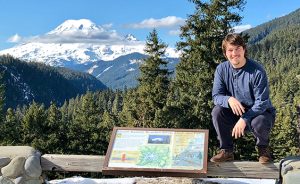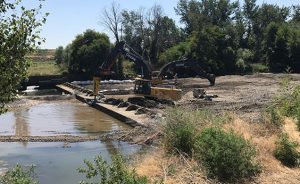
As the director of east Oregon’s Umatilla Basin Watershed Council, alumnus Michael Ward is helping to preserve salmon species across the Pacific Northwest, and in the process he won the 2017 Water Resources Conservation Award for his work.
Steelhead salmon, one of the species Ward works to protect, relies on access to mountain streams in order to spawn. The fish are born in these freshwater streams, and after they mature and travel downstream to the Pacific Ocean, they make their way back upstream to spawn and start the life cycle over again.
However, with a multitude of dams blocking their paths, the Steelhead salmon population, and others like it, are waning.
“These obstructions along the river have negative impacts on the river in general,” Ward said. “But they also completely block fish passage to upstream rearing and spawning habitats.”
There are dozens of dams on the Columbia River alone, and with the help of state and federal agencies as well as the local Native American tribes, Ward, a history alumnus, is doing large-scale restoration projects on the river’s tributaries.
The multi-million dollar project, which has been 20 years in the making, has involved building pipe-lines as well as destroying obstructive dams like the Dillon Diversion Dam, which was removed in 2017.
“When the machines rolled in and made their first cuts in the Dillon Dam last year, that was a moment I don’t think I’ll ever forget in my life,” Ward said. “It was a huge moment. And having the support of the community made it all that much more enjoyable.”

The dam took two months to remove, with the team working from dawn to dusk despite 100-degree temperatures and scorching wildfires.
“We only had a small window to do this work,” Ward said. “We had to get in and out while the water levels were low in the heat of summer, but the work was slow because you constantly have to stop to observe the water quality.”
Ward says that the Dillon Dam removal was just the beginning of the restoration work, and he has already contracted out work until 2021—potentially removing another dam each year.
“It sounds like it’s happening fast,” Ward said. “But I’m kind of lucky to come along right now and get to be the one to implement the projects. It took 20 years for this to line up, and there are a lot of people who spent their entire careers just trying to make this happen. It’s go time now.”
2020 Update
Since 2018, Ward and his team have successfully removed two additional dams that were creating full fish passage barriers for Salmonid species, the Wildhorse Creek Dam and the Reith Dam, and secured funding for the removal of two more dams. If these removals go according to plan, Ward will have succeeded in his initial goal of removing five dams in five years as director. His team has also battled extreme flooding in the area, with back-to-back state of emergency proclamations for flooding, causing his team to quickly find a balance between maintaining infrastructure and preserving local wildlife.
In the future, the Watershed Council will continue to “pick-off” dam removals that rank high in restoring native salmonid fish populations in the Pacific Northwest while looking for opportunities for land and water acquisitions.
Since beginning his position, Ward and his wife have also welcomed four children into their family: their daughter Tillie, identical twin boys Knox and Davis, and newborn boy Danny.